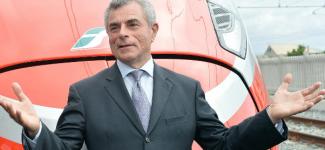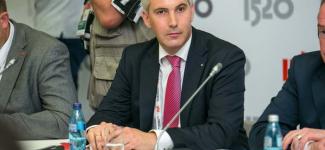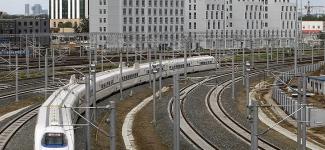Home › Projects › White Book › A vision for seamless transport in the METR region
A vision for seamless transport in the METR region

Michele Molinari, president and CEO Molinari Rail Group, Switzerland
To enable seamless transport from door to door the transport industry needs to embrace technology at all levels. From other industries we can learn that open standards, frequent global interchange and an abolishment of protectionist legislation and operating regulations are the base to push development. This is applicable for any transport development in the METR region respective the New Silk Rail Road between Europe and Asia.
A vision for seamless transport
Transport has played a major role in our society, culture and economy ever since the early days of human kind in Ethiopia. It enables the exchange of goods and ideas across distances. Even with modern communication methods, human contact remains a key success factor for business and personal relationships thus driving the need for transport.
Having frequently travelled near and far, I am probably what many would consider a seasoned traveller. I have experienced and consulted many public transport system around the globe, have discussed their philosophy and transport concepts and learnt a great deal about what a seamless and affordable way of transport can mean for a suburb, a municipality or a metropolitan region. In my opinion, many of these systems are currently in an investment trap, where running the system is inefficient and not meeting the need of its passengers in quality and quantity, while an improvement of the system is prohibited by technological lock-in effects and a new system is financially simply not affordable. However, there are concepts and methods how we in the industry can foster change towards a more seamless transport.
Seamless from start to end
We public transport system planners often forget that transport of persons usually starts at an individual place or building and ends at another building and maybe forget to consider as well how we get from our door to the next stop of our public transport system.
I believe, that it will be possible in the future to life in a world where all means of transport, private and public alike, are interconnected in an easy, understandable and reliable chain from origin to destination.
When planning a new system, to cover the last mile is one of the most challenging tasks. Any change in the modal split requires often a very personal behavior change thus reducing the possible levers for a transport planner. Cities such as Paris with the Vélib bicycle rental and Berlin with the many car-sharing companies but also the Uber concept are frontrunners to provide plannable solutions to these challenges.
Another challenge we often ignore is that sometimes the journey is the destination. Individuals have very different needs, leading to an increasing demand for instance in boat rides on Swiss lakes.
The vision for seamless transport therefore provides a simple platform where all means of transport up to the last mile are connected with one ticket and a reliable timetable is provided and individual needs such as business travel, wheel chair assistance, comfort, or slow travel are considered. Such a system should work for instance from Belaruski Voksal in Moscow to Andermatt in the Swiss Alps, but also from La Defence to the Bastille in Paris covering metro, tram, railway systems, bicycle rental and car sharing.
How do we get there?
Interestingly, we have reached a technological level that already allows this. On the transport system planning, we also have entered these topics and are building the respective models.
To implement such a seamless transport approach we will have to work on the following topics:
- Integral transport system planning
- Individual trip planning supported by electronic personal assistants considering individual needs such as Siri or Cortana.
- Simplified ticketing requires a standardized way of accepting tickets, billing the passengers and sharing the revenue.
- NCF and Bluetooth capability of mobile phones to facilitate ticket control
The question remaining is the implementation and connected with it the investment trap.
Challenges to overcome
The human machine interface will always be customized for operators, regions or even customer segments. What needs to be standardized however is the back-end, thus common systems such as the timetable standards or the machine-to-machine communication can be globally implemented.
The two most important philosophies for fare collection, the gate control and the roving ticket inspectors need to be reconsidered. For instance, a BiBo (Be-in Be-out) system can help reduce operating costs while increasing commonality.
Many systems in the area of billing and trip planning are nowadays off the shelf systems that have no open interfaces and create technological lock-in. A way to overcome these hurdles by reengineering, open source or standardized interfaces is key.
Many operators cannot afford an instant and full change of a billing system to a state of the art system, investment costs need to be therefore reduced and a staged implementation to be made possible. Any new system needs also to be weighted against the maintenance costs of a current system to avoid underfunding in the future, improve both the bottom and top line of the operators.
Where to start
I often ask myself why the transportation industry has not developed in similar speeds as the transistor technology or pharmaceuticals. There are many possible reasons including the investment trap. Still, to improve more rapidly, we need to focus on improving all systems when they reach their end of the life cycle, improve international commonality and reduce protective laws and regulation.
To accelerate towards seamless transportation, we need commencing to embrace the modern technology for all non-safety relevant features:
- A backend system has to be developed that allows in principle to buy a ticket for the PATH in Newark from a ticket machine at a bus stop in St. Petersburg. Similar to the Amadeus in the airline world.
- Individual modes of transport such as car sharing have to be interlinked with public transport systems, so that availability, costs, times etc. are shared.
- BiBo or similar systems have to be implemented at minimal costs (e.g. by WiFi login).
- Apple and Google pay solutions have to be implemented for all transport related merchants.
- Open languages and open source applications have to be developed and supported. Standardized protocols have to be made open source. Examples already working in this direction are for instance OpenTrack with RailML.
We are currently working in Ethiopia, the cradle of humankind where we will support our customer in implementing a more seamless transport for the passengers and freight. Furthermore we are intensifying our engagement in the Middle East especially in Cairo, Egypt where we support the modernization of the urban transport network development.
We are ready to support the New Silk Road development and the transport system development in the METR region together with our partners and customers. In parallel to the mainline development of the new international transport corridors as presented with the new Metro of the METR in the Turin in May this year, the attractiveness of rail transportation has to be increased as well in the stations of this new Metro, the cities. Modern and attractive urban and regional transport solutions will feed in the future more efficiently the new network and to reach this exchange of best practices throughout the region will become a key momentum for the overall development. As Molinari Rail is engaged in the mainline and urban transport development throughout the METR region we are ready to contribute and share this experience with the players in the METR region. I am convinced that seamless transport for passengers will increase the shift2rail in this region as the most sustainable and environmental friendliest means of transportation.
http://www.kommersant.ru/doc/2768178
Sign up for MIR initiative email updates
Sign up to receive monthly notifications about new arctiles published and other events on your email.
Other articles
 Eugenio Muzio
Eugenio Muzio
Eurasian High-Speed Metro for Freight Transportation
 Mauro Moretti
Mauro Moretti
METR region transport systems
 Jan C. Harder
Jan C. Harder
Localisation as a challenge
 Zhu Ying
Zhu Ying
High speed railway’s impact on China
 Jean-Pierre Loubinoux
Jean-Pierre Loubinoux
An International Platform for Railway Transport Integration
 Niko Warbanoff
Niko Warbanoff
